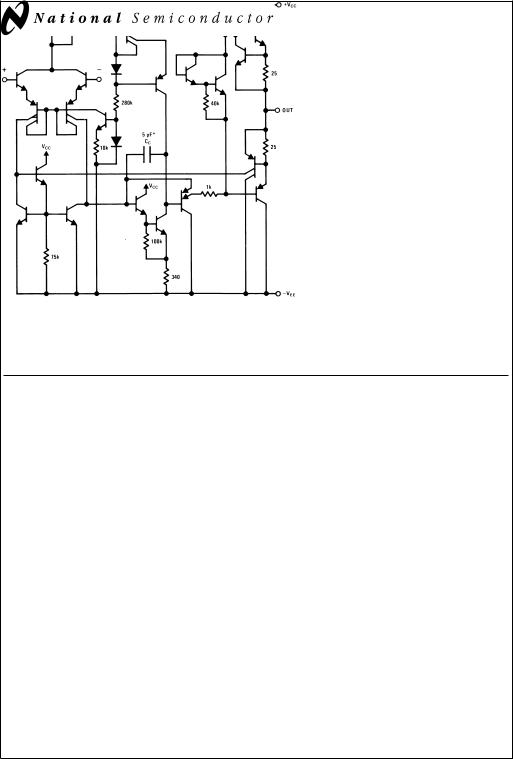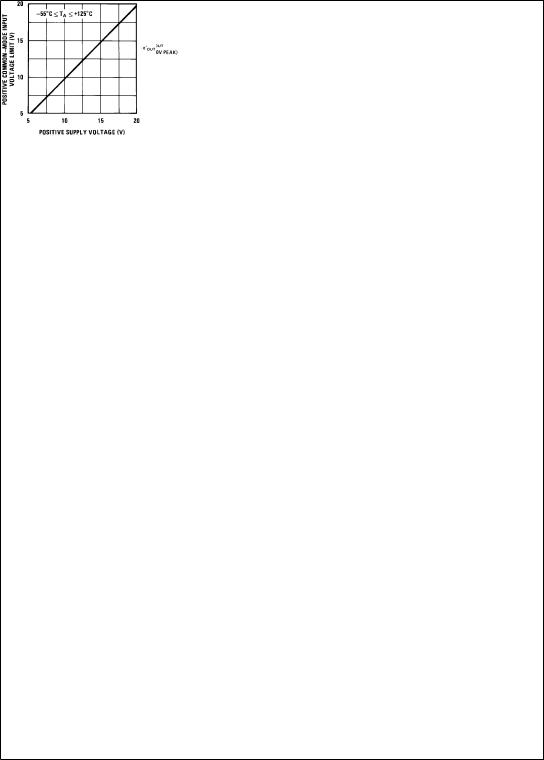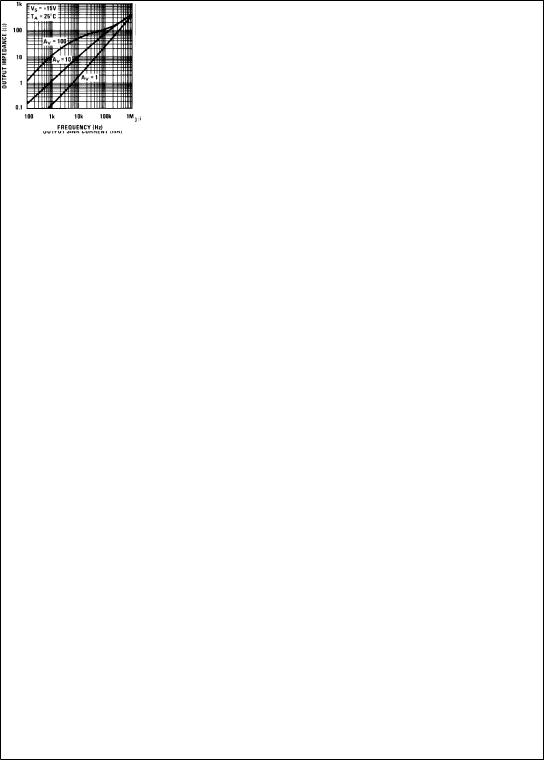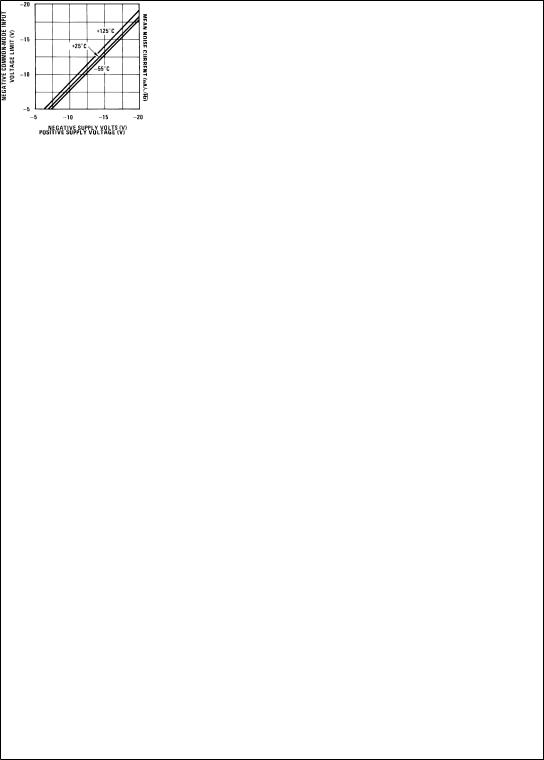NSC LM148MW8, LM148J-883, LM148E-883, JM38510-11001SD, JM38510-11001SC Datasheet
...
May 1999
LM148/LM248/LM348
Quad 741 Op Amps
LM149
Wide Band Decompensated (AV (MIN) = 5)
General Description
The LM148 series is a true quad 741. It consists of four independent, high gain, internally compensated, low power operational amplifiers which have been designed to provide functional characteristics identical to those of the familiar 741 operational amplifier. In addition the total supply current for all four amplifiers is comparable to the supply current of a single 741 type op amp. Other features include input offset currents and input bias current which are much less than those of a standard 741. Also, excellent isolation between amplifiers has been achieved by independently biasing each amplifier and using layout techniques which minimize thermal coupling. The LM149 series has the same features as the LM148 plus a gain bandwidth product of 4 MHz at a gain of 5 or greater.
The LM148 can be used anywhere multiple 741 or 1558 type amplifiers are being used and in applications where amplifier matching or high packing density is required.
Features
n741 op amp operating characteristics
nLow supply current drain: 0.6 mA/Amplifier
nClass AB output stage Ð no crossover distortion
nPin compatible with the LM124
nLow input offset voltage: 1 mV
nLow input offset current: 4 nA
nLow input bias current: 30 nA
nGain bandwidth product
LM148 (unity gain): 1.0 MHz
LM149 (AV ³ 5): 4 MHz
nHigh degree of isolation between amplifiers: 120 dB
nOverload protection for inputs and outputs
Schematic Diagram
DS007786-1
* 1 pF in the LM149
Amp Op 741 Quad Series LM148/LM149
© 1999 National Semiconductor Corporation |
DS007786 |
www.national.com |

Supply Voltage |
±22V |
±18V |
±18V |
Differential Input Voltage |
±44V |
±36V |
±36V |
Output Short Circuit Duration (Note 1) |
Continuous |
Continuous |
Continuous |
Power Dissipation (Pd at 25ÊC) and |
|
|
|
Thermal Resistance (qjA), (Note 2) |
|
|
|
Molded DIP (N) Pd |
Ð |
Ð |
750 mW |
qjA |
Ð |
Ð |
100ÊC/W |
Cavity DIP (J) Pd |
1100 mW |
800 mW |
700 mW |
qJA |
110ÊC/W |
110ÊC/W |
110ÊC/W |
Maximum Junction Temperature (TjMAX) |
150ÊC |
110ÊC |
100ÊC |
Operating Temperature Range |
−55ÊC £ TA £ +125ÊC |
−25ÊC £ TA £ +85ÊC |
0ÊC £ TA £ +70ÊC |
Storage Temperature Range |
−65ÊC to +150ÊC |
−65ÊC to +150ÊC |
−65ÊC to +150ÊC |
Lead Temperature (Soldering, 10 sec.) Ceramic |
300ÊC |
300ÊC |
300ÊC |
Lead Temperature (Soldering, 10 sec.) Plastic |
|
|
260ÊC |
Soldering Information |
|
|
|
Dual-In-Line Package |
|
|
|
Soldering (10 seconds) |
260ÊC |
260ÊC |
260ÊC |
Small Outline Package |
|
|
|
Vapor Phase (60 seconds) |
215ÊC |
215ÊC |
215ÊC |
Infrared (15 seconds) |
220ÊC |
220ÊC |
220ÊC |
See AN-450 ªSurface Mounting Methods and Their Effect on Product Reliabilityº for other methods of soldering surface mount |
|||
devices. |
|
|
|
ESD tolerance (Note 5) |
500V |
500V |
500V |
|
Electrical Characteristics |
|
|
|
|
|
|
|
|
|
|
|
|
|
|
|
(Note 3) |
|
|
|
|
|
|
|
|
|
|
|
|
|
|
|
|
|
|
|
|
|
|
|
|
|
|
|
|
|
|
|
Parameter |
Conditions |
|
LM148/LM149 |
|
LM248 |
|
|
LM348 |
|
Units |
|
|||
|
|
|
|
|
|
|
|
|
|
|
|
|
|
|
|
|
|
|
|
Min |
Typ |
Max |
Min |
|
Typ |
Max |
Min |
Typ |
Max |
|
|
|
|
|
|
|
|
|
|
|
|
|
|
|
|
|
|
|
Input Offset Voltage |
TA = 25ÊC, RS £ 10 kW |
|
|
1.0 |
5.0 |
|
|
1.0 |
6.0 |
|
1.0 |
6.0 |
mV |
|
|
Input Offset Current |
TA = 25ÊC |
|
|
4 |
25 |
|
|
4 |
50 |
|
4 |
50 |
nA |
|
|
Input Bias Current |
TA = 25ÊC |
|
|
30 |
100 |
|
|
30 |
200 |
|
30 |
200 |
nA |
|
|
Input Resistance |
TA = 25ÊC |
|
0.8 |
2.5 |
|
0.8 |
|
2.5 |
|
0.8 |
2.5 |
|
MW |
|
|
Supply Current All Amplifiers |
TA = 25ÊC, VS = ±15V |
|
|
2.4 |
3.6 |
|
|
2.4 |
4.5 |
|
2.4 |
4.5 |
mA |
|
|
Large Signal Voltage Gain |
TA = 25ÊC, VS = ±15V |
|
50 |
160 |
|
25 |
|
160 |
|
25 |
160 |
|
V/mV |
|
|
|
VOUT = ±10V, RL ³ 2 kW |
|
|
|
|
|
|
|
|
|
|
|
|
|
|
Amplifier to Amplifier |
TA = 25ÊC, f = 1 Hz to 20 kHz |
|
|
|
|
|
|
|
|
|
|
|
|
|
|
Coupling |
(Input Referred) See Crosstalk |
|
|
−120 |
|
|
|
−120 |
|
|
−120 |
|
dB |
|
|
|
Test Circuit |
|
|
|
|
|
|
|
|
|
|
|
|
|
|
|
|
|
|
|
|
|
|
|
|
|
|
|
|
|
|
Small Signal Bandwidth |
LM148 Series |
|
|
1.0 |
|
|
|
1.0 |
|
|
1.0 |
|
MHz |
|
|
|
TA = 25ÊC |
|
|
|
|
|
|
|
|
|
|
|
|
|
|
|
LM149 Series |
|
|
4.0 |
|
|
|
4.0 |
|
|
4.0 |
|
MHz |
|
|
|
|
|
|
|
|
|
|
|
|
|
|
|
|
|
|
Phase Margin |
LM148 Series (AV = 1) |
|
|
60 |
|
|
|
60 |
|
|
60 |
|
degrees |
|
|
|
TA = 25ÊC |
|
|
|
|
|
|
|
|
|
|
|
|
|
|
|
LM149 Series (AV = 5) |
|
|
60 |
|
|
|
60 |
|
|
60 |
|
degrees |
|
|
Slew Rate |
LM148 Series (AV = 1) |
|
|
0.5 |
|
|
|
0.5 |
|
|
0.5 |
|
V/µs |
|
|
|
TA = 25ÊC |
|
|
|
|
|
|
|
|
|
|
|
|
|
|
|
LM149 Series (AV = 5) |
|
|
2.0 |
|
|
|
2.0 |
|
|
2.0 |
|
V/µs |
|
|
Output Short Circuit Current |
TA = 25ÊC |
|
|
25 |
|
|
|
25 |
|
|
25 |
|
mA |
|
|
Input Offset Voltage |
RS £ 10 kW |
|
|
|
6.0 |
|
|
|
7.5 |
|
|
7.5 |
mV |
|
|
Input Offset Current |
|
|
|
|
75 |
|
|
|
125 |
|
|
100 |
nA |
|
|
|
|
|
|
|
|
|
|
|
|
|
|
|
|
|
|
|
|
|
|
|
|
|
|
|
|
|
|
|
|
|
www.national.com |
|
2 |
|
|
|
|
|
|
|
|
|
|
|
|
|

Electrical Characteristics (Continued)
(Note 3)
Parameter |
Conditions |
LM148/LM149 |
|
LM248 |
|
|
LM348 |
|
Units |
|||
|
|
Min |
Typ |
Max |
Min |
Typ |
Max |
Min |
Typ |
Max |
|
|
|
|
|
|
|
|
|
|
|
|
|
|
|
Input Bias Current |
|
|
|
325 |
|
|
|
500 |
|
|
400 |
nA |
Large Signal Voltage Gain |
VS = ±15V, VOUT = ±10V, |
25 |
|
|
15 |
|
|
|
15 |
|
|
V/mV |
|
RL > 2 kΩ |
|
|
|
|
|
|
|
|
|
|
|
Output Voltage Swing |
VS = ±15V, RL = 10 kΩ |
±12 |
±13 |
|
±12 |
±13 |
|
|
±12 |
±13 |
|
V |
|
RL = 2 kΩ |
±10 |
±12 |
|
±10 |
±12 |
|
|
±10 |
±12 |
|
V |
Input Voltage Range |
VS = ±15V |
±12 |
|
|
±12 |
|
|
|
±12 |
|
|
V |
Common-Mode Rejection |
RS ≤ 10 kΩ |
70 |
90 |
|
70 |
90 |
|
|
70 |
90 |
|
dB |
Ratio |
|
|
|
|
|
|
|
|
|
|
|
|
|
|
|
|
|
|
|
|
|
|
|
|
|
Supply Voltage Rejection |
RS ≤ 10 kΩ, ±5V ≤ VS ≤ ±15V |
77 |
96 |
|
77 |
96 |
|
|
77 |
96 |
|
dB |
Note 1: Any of the amplifier outputs can be shorted to ground indefinitely; however, more than one should not be simultaneously shorted as the maximum junction temperature will be exceeded.
Note 2: The maximum power dissipation for these devices must be derated at elevated temperatures and is dicated by TjMAX, θjA, and the ambient temperature, TA. The maximum available power dissipation at any temperature is Pd = (TjMAX − T A)/θjA or the 25ÊC PdMAX, whichever is less.
Note 3: These specifications apply for VS = ±15V and over the absolute maximum operating temperature range (TL ≤ TA ≤ TH) unless otherwise noted.
Note 4: Refer to RETS 148X for LM148 military specifications and refer to RETS 149X for LM149 military specifications.
Note 5: Human body model, 1.5 kΩ in series with 100 pF.
Cross Talk Test Circuit
DS007786-6 |
DS007786-7 |
VS = ±15V
Application Hints
The LM148 series are quad low power 741 op amps. In the proliferation of quad op amps, these are the first to offer the convenience of familiar, easy to use operating characteristics of the 741 op amp. In those applications where 741 op amps have been employed, the LM148 series op amps can be employed directly with no change in circuit performance.
The LM149 series has the same characteristics as the LM148 except it has been decompensated to provide a wider bandwidth. As a result the part requires a minimum gain of 5.
The package pin-outs are such that the inverting input of each amplifier is adjacent to its output. In addition, the amplifier outputs are located in the corners of the package which
simplifies PC board layout and minimizes package related capacitive coupling between amplifiers.
The input characteristics of these amplifiers allow differential input voltages which can exceed the supply voltages. In addition, if either of the input voltages is within the operating common-mode range, the phase of the output remains correct. If the negative limit of the operating common-mode range is exceeded at both inputs, the output voltage will be positive. For input voltages which greatly exceed the maximum supply voltages, either differentially or common-mode, resistors should be placed in series with the inputs to limit the current.
3 |
www.national.com |

Application Hints (Continued)
Like the LM741, these amplifiers can easily drive a 100 pF capacitive load throughout the entire dynamic output voltage and current range. However, if very large capacitive loads must be driven by a non-inverting unity gain amplifier, a resistor should be placed between the output (and feedback connection) and the capacitance to reduce the phase shift resulting from the capacitive loading.
The output current of each amplifier in the package is limited. Short circuits from an output to either ground or the power supplies will not destroy the unit. However, if multiple output shorts occur simultaneously, the time duration should be short to prevent the unit from being destroyed as a result of excessive power dissipation in the IC chip.
As with most amplifiers, care should be taken lead dress, component placement and supply decoupling in order to en-
sure stability. For example, resistors from the output to an input should be placed with the body close to the input to minimize ªpickupº and maximize the frequency of the feedback pole which capacitance from the input to ground creates.
A feedback pole is created when the feedback around any amplifier is resistive. The parallel resistance and capacitance from the input of the device (usually the inverting input) to AC ground set the frequency of the pole. In many instances the frequency of this pole is much greater than the expected 3 dB frequency of the closed loop gain and consequently there is negligible effect on stability margin. However, if the feedback pole is less than approximately six times the expected 3 dB frequency a lead capacitor should be placed from the output to the input of the op amp. The value of the added capacitor should be such that the RC time constant of this capacitor and the resistance it parallels is greater than or equal to the original feedback pole time constant.
Typical Performance Characteristics
Supply Current |
Input Bias Current |
Voltage Swing |
DS007786-23 DS007786-24 DS007786-25
Positive Current Limit Negative Current Limit Output Impedance
DS007786-28
DS007786-26 |
DS007786-27 |
www.national.com |
4 |

Typical Performance Characteristics (Continued)
Common-Mode Rejection |
Open Loop Frequency |
Bode Plot LM148 |
Ratio |
Response |
|
DS007786-31
DS007786-29
|
|
DS007786-30 |
Bode Plot LM149 |
Large Signal Pulse |
Large Signal Pulse |
|
Response (LM148) |
Response (LM149) |
|
DS007786-32 |
|
|
DS007786-33 |
DS007786-34 |
Small Signal Pulse |
Small Signal Pulse |
Undistorted Output |
Response (LM148) |
Response (LM149) |
Voltage Swing |
DS007786-35 |
DS007786-36 |
DS007786-37 |
5 |
www.national.com |

Typical Performance Characteristics (Continued)
Gain Bandwidth |
Slew Rate |
Inverting Large Signal Pulse |
|
|
Response (LM149) |
DS007786-38 DS007786-39
DS007786-40
Inverting Large Signal Pulse |
Input Noise Voltage and |
Positive Common-Mode |
Response (LM148) |
Noise Current |
Input Voltage Limit |
DS007786-41 |
DS007786-42 |
|
DS007786-43 |
Negative Common-Mode Input
Voltage Limit
DS007786-5
www.national.com |
6 |
